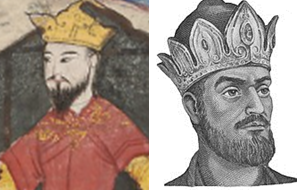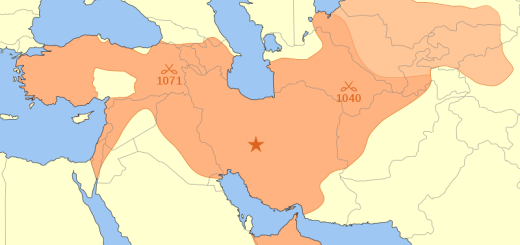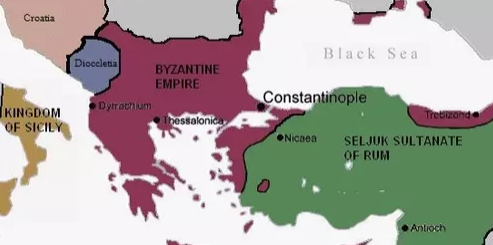Seljuk Dynasty: History, Origins, Rulers, & Facts
The Seljuq dynasty was a Turkish dynasty that hailed from the Oguz (Ghuzz) Turkic tribes. The Seljuqs would go on to invade southwestern Asia before establishing the Seljuq Empire and the Sultanate of Rum in the 11th century.
At its peak, the Seljuks held control over areas in modern day Iran, Syria, Palestine, and Turkiye. Their expansion into territories held by the Byzantine Empire made them huge targets of the First Crusaders, whose goal was to take back the Holy Land from Islamic rulers.
Quick Facts: Seljuk Dynasty
Founder: Seljuk
Country: Seljuk Empire, Sultanate of Rum
Founded in: 10th century
Religion: Sunni Islam
Other names: Al-e Saljuq (in Persian), the Saljuqids, Seljuk Turkomans, Seljuk Turks
Origins
Responsible for the establishment of the Seljuk Empire and the Sultanate of Rum, the Seljuk dynasty origins can be traced to a group (i.e. the Kinik branch) of Oghuz Turkic.
Around the 8th century, the Oghuz Turks took residence in the Oghuz Yabgu State in the north of the Caspian Sea and Aral Sea.
And about two centuries later, the Oghuz Turks started interacting with a number of Muslim cities. It was also around this time that warlord Seljuk Beg, leader of the Seljuk clan, parted ways with the Oghuz Yabghu State.
The warlord Seljuk led his clan to the west bank of the lower Syr Darya (Jaxartes), a river in Central Asia.

Migration into mainland Persia
In the last few decades of the 10th century, a significant historical event occurred involving the warlord Seljuk and his clan. During this period, Seljuk and his followers embraced Islam as their religion. This conversion to Islam had significant consequences for their future actions and their interactions with the surrounding regions.
After adopting Islam, Seljuk and his clan decided to migrate from their original homeland in Central Asia. They embarked on a journey towards mainland Persia, specifically targeting the province of Khurasan in eastern Iran as their destination.
This migration was likely driven by a combination of factors, including the desire for new opportunities, fertile lands, and perhaps religious motivations associated with their newfound faith.
Upon arriving in Khurasan, the Seljuk clan found themselves in direct contact with the Ghaznavid Empire, which was a prominent Islamic dynasty ruling over parts of Persia and the broader region during that time. This confrontation with the Ghaznavid Empire marked a critical phase in the Seljuk’s history and played a pivotal role in shaping their future.
The encounter with the Ghaznavids resulted in a series of conflicts and power struggles, as the Seljuks sought to establish themselves in the region and potentially challenge the existing authority of the Ghaznavid rulers.
Over time, the Seljuks’ military prowess and political ambitions allowed them to gain prominence and eventually establish their own dynasty, known as the Seljuk Empire, which went on to become a major force in the Islamic world and played a significant role in shaping the history of the Middle East and Persia in the centuries that followed.

The Great Seljuk Empire
At the Battle of Nasa plains in 1305, the Seljuks defeated the Ghaznavid dynasty, a Persianate Muslim dynasty of Turkic mamluk origin.
Subsequent victories over the Ghaznavids, including at the Battle of Dandanaqan in 1040 near the city of Merv (modern-day Turkmenistan), allowed the Seljuks to dominate the Khorasan region. The Seljuks were led by warlords Tughril and his brother Chaghri Beg, who were the grandsons of Seljuk.
Out of those victories, the Seljuks were able to establish an empire that would later become the Great Seljuk Empire. It’s also said that the Abbasid calip al-Qai’im approved of Seljuk rule over the region.

The Great Seljuk Empire in the late 11th century
Did you know…?
Historians state that the many of the people of Western Turks (i.e. modern day Turkmenistan, Turkey, the Republic of Azerbaijan, and Iranian Azerbaijan) can trace their ancestry to the Seljuk Empire.
Examples of famous Seljuk rulers (i.e. “Great Seljuks”)
The rulers of the Seljuk dynasty were known as the Great Seljuk.
Tughril and Chaghri

Tughril and his brother Chaghri Beg were the grandchildren of Seljuk, the famous warlord. Image: Toghrol Tower, a 12th-century monument south of Tehran, Iran, commemorating Seljuk ruler Toğrül
The first ruler of the Seljuk Empire was Tughril (c. 993-1063), who was born Abu Talib Muhammad Tughril ibn Mika’il. Tughril is regarded as the founder of the Seljuk Empire. He was powerful military leader who brought many Turkmen warriors of Central Asia under his control.
It is said that Tughril marched with his army to conquer many places in western Iran. He also captured the city of Baghdad from the Abbasids.
Shortly after, he and his brother Chaghri Beg founded the Seljuk Sultanate. Tughril was driven by his goal to take the boundaries of his empire into places in the Byzantine Empire as well as territories under the control of the Fatimid Caliphate.
Tughril’s victory in Baghdad allowed him to unite the various Muslim tribes under the Sunni caliphate.

Examples of famous Seljuk rulers (i.e. “Great Seljuks”) include Tughril, Alp Arslan, and Malik Shah I
After his death in 1063, his nephew Alp Arslan (son of Tughril’s brother Chaghri Beg) succeeded him to the throne. For example, Alp Arslan’s victory at the Battle of Manzikert in 1071 was a major turning point in the Seljuk-Byzantine rivalry.
Other notable Seljuk rulers include Malik Shah, and Sanjar. Each of these rulers left a lasting legacy in various aspects of the empire’s history.
Demise
The Seljuk dynasty was replaced by the Khwarazmian dynasty (also known as the Anushteginid dynasty), who was initially vassals of the Seljuks. The Khwarazmian dynasty was in turn conquered during the Mongol invasions in the 13th century.

Over time, the Seljuk Empire faced internal divisions and external pressures, leading to its fragmentation into smaller Seljuk Sultanates.
Other major facts about the Seljuks and their rulers

Image: Double-headed eagle (Selçuklu kartalı), used as a symbol by several Seljuk rulers
- The gains made by the Seljuk Empire in eastern Anatolia likely triggered the First Crusade (1095-1099).
- Examples of rulers to hold the title of Sultan of Seljuk Empire include Malik Shah I (reign – 1072-1092), Mahmud bin Malik Shah (reign- 1092-1094), and Muhammad I Tapar (1105-1118).
- During the reigns of Alp-Arslan and Malik-Shah, the Seljuq Empire grew to cover all of Syria, Palestine, Iran and many other Mesopotamian areas.
- Alp-Arslan famously defeated the Byzantine Empire at the Battle of Manzikert. He also took into custody the Byzantine emperor Romanus IV Diogenes.
- The name Khorasan in Persian evokes the meaning “where the sun arrives from” or “the Eastern Province”.



























